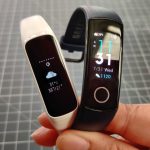Two of the major aspects of being healthy are nutrition and exercise. With the growing popularity of smart wearables, things like exercise, food intake, heart-rate, and sleep can be tracked to get a better view of the progress. But iOS already has the Activity app which tracks your movements and exercises recorded by the Apple Watch. So how does Google Fit compare to Activity app? Let’s find out.
Points vs. Rings
The main job of both apps is tracking your movements throughout the day. These apps monitor your general movements like walking and climbing stairs to many different exercises like Running, Swimming, Rowing, etc. The way they represent the info at the end of the day differs. Google Fit uses Points and Move minutes while Activity uses Rings, which you have to complete daily. The number of Heart Points and Move Minutes you need to complete daily depend upon your sex, age and weight. For me, it’s 60 move minutes and 10 Heart Points. It counts any movement involving more than 30 steps as one move minute. Similarly, one minute of moderate activity counts as one Heart Point while one minute of vigorous activity counts as two Heart Points. It distinguishes moderate and vigorous exercise based on your Heart rate. In comparison, Activity app employs a much simpler system of three Rings, each representing Move, Exercise, and Stand. Here too, the goal for each ring depends on your stats. Move is tracked in calories, Exercise in minutes and Stand in hours, i.e., how many hours you were on your feet? I find this system much easier to keep track of instead of doing mental calculations about how much exercise is needed to earn that last 2 Heart points.
Tracking Your Workouts
Google Fit gets all the data from the Health app on iOS, just like Activity. The tracked data provided to both apps is the same. The way your tracked workouts are shown is different in both the apps. Google Fit takes the simpler route, showing only the basic information like Distance covered, and Calories burned. It also shows how many Move Minutes and Heart points that workout earned you. In contrast, Activity gives you a detailed overview of the workout. For example, in the above two screenshots for the same swimming workout, Google Fit does not show the time taken for each lap. Neither does it show the swimming style of each lap.
Both of them show Heart rate info in form of graph, but only Google Fit allows you to drag along the graph to know your heart rate at a given time in the workout. This info is important for someone who follows HIIT exercise regime.
Rewarding the User
We all like being recognized and rewarded for our work, especially if the task accomplished is a tough one. Working out in the gym or going out for a run in the chilly morning are things, which nobody does out of pure joy. One needs that sheer will and dedication to keep working out regularly. Activity encourages you to do it by giving out awards when certain milestones are achieved. You have awards for the most calories burned in a day, the highest time spent doing an exercise and many more. While not significantly as motivating as seeing that fit guy or girl in the gym, the awards do bring a competitive feel to the whole thing. As Google Fit does not have this aspect at all, we can’t really compare anything here.
Light Mode vs Dark Mode
When it comes to the UI part, both the apps are a contrast of each other, literally. Google Fit has a bright design with a white background, while Activity has a dark mode-like theme with colorful UI elements. As both are as different as black and white, your preferences come into play. For dark mode lovers like me, I prefer Activity’s look over Google Fit. In the end, the layout of both the apps is more or less same, with different tabs at the bottom of the screen for things like workouts and tracking history.
Other Miscellaneous Things
In Google Fit, you need to enter your vital stats like sex, weight, height, and age. Based on that, the app will set the Daily Goal for you. In the case of Activity, this data is taken from the Health app. There is also provision for adding a workout in Google Fit, while in Activity there is none. The only way you can add a workout in Activity manually is through any external app like Endomondo or Strava, which will sync the data to Activity. The Activity also has a sharing feature where you can share your workouts. But, the downside is that you can do so with other Activity users only. There is no integration of sharing directly to Facebook, Twitter or Instagram. So, you will need to manually post or tweet, boasting about your latest 1-mile run.
Work Hard, Track Harder
Honestly, there is no real competition here. As Google Fit and Activity receive the health and exercise data from the Health app, it comes down to the presentation. And, as Activity is Apple’s in-house app, it has an advantage in many areas. The Rings are mirrored on your Apple Watch with the UI and color scheme also being the same. The close integration with Apple Watch is another strong point. Using Google Fit breaks this continuity as you have Points in the app while Rings on your Apple Watch. Further, it’s a no-brainer to point out that Google Fit is more at home in the Android Ecosystem. So it is entirely up to you to choose one. The above article may contain affiliate links which help support Guiding Tech. However, it does not affect our editorial integrity. The content remains unbiased and authentic.














![]()
![]()


